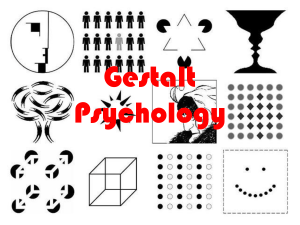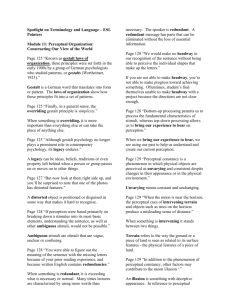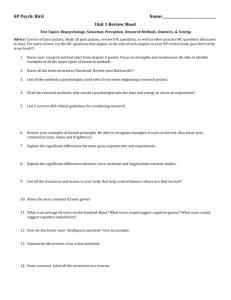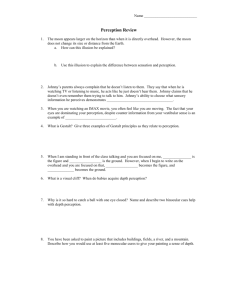PY262.11.PercObjects
advertisement
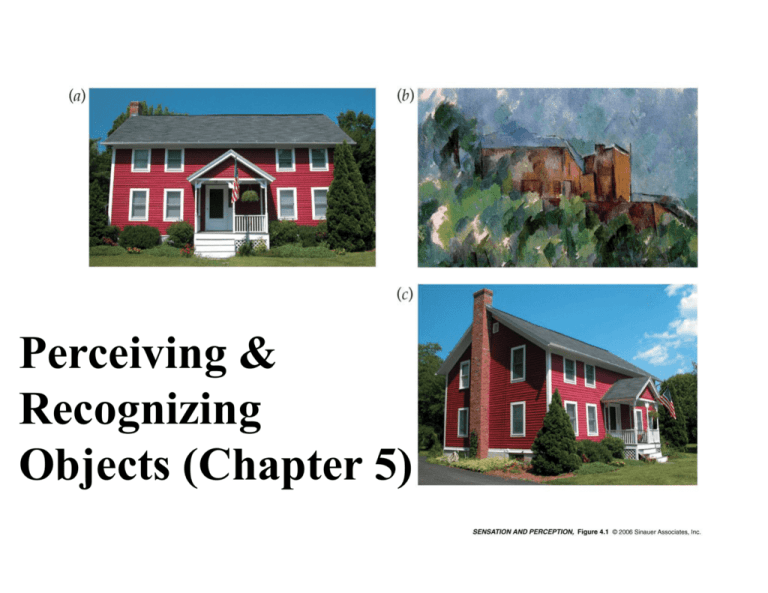
Perceiving & Recognizing Objects (Chapter 5) Wilhelm Wundt (1879): Our PERCEPTION is constructed from the combinations of our SENSATIONS Copyright © 2002 Wadsworth Group. Wadsworth is an imprint of the Wadsworth Group, a division of Thomson Learning What is this object? Can you “reverse frame?” 1. Cube floating over dark circles? • Cube seen through (or behind) holes or perforations? Gestalt Psychology In response to Wilhelm Wundt (1879) who proposed that “perception” was a function of “sensation” Gestalt psychologists were struck by the many ways in which our perceptions transcend the simple sensations from which they are built… and the importance of the “organization of perception” "The whole is different/greater than the sum of the parts" How do we “organize” (i.e., cluster, group, give meaning, prioritize) our sensations into perception? How do we “organize” (i.e., cluster, group, give meaning, prioritize) our sensations into perception? Gestalt Psychology - Perceptual Organization "The whole is different than the sum of the parts" Six Gestalt Laws of Perceptual Organization 1. “Pragnanz” – the law of “good figure,” “law of closure” or “law of simplicity” “Every stimulus pattern is seen in such a way that the resulting structure is as simple as possible” Related to the scientific concept of “parsimony:” In selecting a criterion for deciding among scientific theories or explanations, one should always choose the simplest explanation of a phenomenon, the one that requires the fewest leaps of logic. Gestalt Laws Pragnanz - good figure or simplicity Gestalt Laws Pragnanz - good figure or simplicity Gestalt Laws Pragnanz - good figure or simplicity Good fit, closure, simplicity Six Gestalt Laws of Perceptual Organization 2. Law of Similarity “Similar things appear to be grouped together” Circles and squares are evenly spaced both horizontally and vertically, yet we “see” vertical columns. Why? Because we group things that are similar. Law of Similarity Six Gestalt Laws of Perceptual Organization 3. Law of good continuation – “Points that, when connected, result in straight or smoothly curving lines are seen in such a way as to follow the smoothest path.” “Perceptual path of least resistance” What defines these lines? a c? or a b? c b? or c d? Determined by smoothness Six Gestalt Laws of Perceptual Organization 4. Law of proximity (or nearness) – “Things that are near to each other appear to be grouped together” This guy doesn’t “belong” Law of Proximity Proximity defines propinquity (kinship) Six Gestalt Laws of Perceptual Organization 5. Law of Common Fate “Things that are moving in the same direction appear to be grouped together” – choreography of movement Six Gestalt Laws of Perceptual Organization 6. Law of familiarity (or meaningfulness) – “Things are more likely to form groups if the groups appear familiar or meaningful” Meaningfulness (Familiarity) Six Gestalt Laws of Perceptual Organization 6. Law of familiarity (or meaningfulness) – “Things are more likely to form groups if the groups appear familiar or meaningful” What do you see below? Six Gestalt Laws of Perceptual Organization 6. Law of familiarity (or meaningfulness) – “Things are more likely to form groups if the groups appear familiar or meaningful” Find the hidden faces below Six Gestalt Laws of Perceptual Organization 6. Law of familiarity (or meaningfulness) – “Things are more likely to form groups if the groups appear familiar or meaningful” There are allegedly 12 faces Elaborations of the “laws:” Palmer and Rock • Principle of common region • Principle of element connectedness • Principle of synchrony Elaborations of the “laws:” Palmer and Rock • Principle of common region • Principle of element connectedness • Principle of synchrony Elaborations of the “laws:” Palmer and Rock • Principle of common region • Principle of element connectedness • Principle of synchrony Elaborations of the “laws:” Palmer and Rock • Principle of common region • Principle of element connectedness • Principle of synchrony Elaborations of the “laws:” Palmer and Rock • Principle of common region • Principle of element connectedness • Principle of synchrony Gestalt Principles are “Heuristics:” the difference between algorithms and principles (i.e., best guess, ruleof-thumb, source of hypothesis testing) Likelihood principle - von Helmholtz -we will perceive an object that is most likely the cause of our sensory stimulation (hypothesis testing) How do we perceive objects in our world? Summary of Gestalt rules 1. 2. 3. 4. 5. 6. Good fit, closure, simplicity Classical Gestalt Similarity “laws” Good continuity Proximity Common fate Familiarity (meaningfulness) 7. Common region 8. Connectedness 9. Synchrony Modern Gestalt “laws” Remember, How do we perceive objects is dependent on how we separate (segment, segregate) objects Fundamental Gestalt question: How do we separate (segment, segregate) objects • Understanding “Figure-Ground” • Are there properties of figure and ground? Figure-Ground segregation The figure is more “thing-like” than the ground Figure-Ground segregation What is this? Figure-Ground segregation 1. “Figure” is perceived as being “in front” of the ground 2. “Ground” tends to be perceived in the surrounding pattern 3. “Figure” is perceived as the smaller object 4. “Surroundedness” Figure -Ground Segregation Small things generally are seen as figure Figure against the ground Figure-Ground segregation The ground is seen as unformed material and seems to extend behind the figure… The contour (i.e., lines/edges/endings) separating the figure from the ground appears to belong to the figure. Figure -Ground Segregation Symmetrical areas tend to be seen as figure Figure -Ground Segregation Symmetry (i.e., both sides convex or concave) generally is seen as figure Symmetry is indicated in “parallelism” Figure -Ground Segregation Meaningful things generally are seen as figure Figure -Ground Segregation Meaningful things generally are seen as figure Properties of Figure and Ground? 1. “Thing-like” appearance 2. Figure is perceived as “in front” of ground 3. Ground is perceived by a surrounding stimulus (“surroundedness”) 4. Figure is perceived as the smaller object 5. Ground is unformed 6. Contour “belongs” to the figure 7. Figure is seen in the symmetry of forms (opposite-mirror images or parallel images “belong” together) 8. Meaningfulness of information can infer figure-ground Alternative models (alternative “levels of analysis”) to how we “construct” objects in perception David Marr (1982) Vision “Computational Approach” to object perception Individual Groups of Features Features Retina, LGN, Cortical Hypercolumns analyses Objects Extrastriate Cortical regions (Inferotemporal lobe, V4 (color), etc.) Scenes Extrastriatal “cross-talk” & synchrony (IT, MT, Parietal lobe, feedback to LGN, etc.) Object Perception in Stages Anne Treisman's "feature integration theory" (FIT) Preattentive Stage identify Primitives (line/edge) preattentive "automatic" processing Focused Attention Stage attentional devise -focus on some features Chapter 6: Attention and Experiencing a Coherent World Pages 142-145 combine features or primitives Perception of three dimensional world Compare to memory Identify Object Object Perception in Stages Treisman's "feature integration theory" (FIT) identify primitives preattentive "automatic" processing Preattentive Stage: Visual system (retina, LGN, Hypercolumns) analyzes features such as curvature, orientation, length, color, movement, etc. “Non-conscious processes” Preattentive Stage: Identify and analyze “primitives” (i.e., features) How do we see features? Method 1 “pop-out” boundaries Example of when pop-out occurs: when there are texturally different fields Example of when pop-out occurs: when there are different texture fields Items that POP OUT are visual primitives - line orientation, curvature, color, depth, line ends, motion etc. O O O O O O O O O O O Why doesn't the red vertical bar POP OUT? Because it requires attention and analysis Object Perception in Stages Treisman's "feature integration theory" (FIT) identify primitives preattentive "automatic" processing Focused attention: attentional devise -focus on some features Narrows the range of what an individual attends to in the wider visual array Object Perception in Stages Treisman's "feature integration theory" (FIT) identify primitives preattentive "automatic" processing Focused attention: attentional devise -focus on some features combine features or primitives Narrows the range of what an individual attends to in the wider visual array With narrowed attention, features are combined and object is perceived Object Perception in Stages Treisman's "feature integration theory" (FIT) identify primitives preattentive "automatic" processing attentional devise -focus on some features combine features or primitives Perception of three dimensional world Compare to memory Identify Object Focused Attention Stage: What if the stimulus doesn’t just “pop-out?” How do we see features? Method 2 visual search and “back-end” processing of Feature Integration Theory Need for combining & perceiving objects & using cognitive processes (i.e., comparing to memory) Focused Attention Stage: What if the stimulus doesn’t just “pop-out?” How do we see features? Method 2 visual search and “back-end” processing of Feature Integration Theory Combining & perceiving (c) requires both Ventral (“what is it?”) and Dorsal (“where is it?”) pathways and cross-talk of both Example of when pop-out does NOT occur: when comparison to memory is involved Pop-Out in Visual Search - Anne Treisman 2 distractors V O V T 5 distractors T V L O V V V V T T T L T T 10 distractors V V V O V V V V V V V T T T T LT T T T T T Reaction Time To find a red vertical bar amongst green vertical bars 2 5 10 Reaction Time # of distractors To find an "L" amongst "T"s 2 5 10 # of distractors Anne Treisman’s conclusions about Basic Features • Pop-out occurs with stimuli such as: – – – – – – Curvature Orientation Line ends/lengths Movement Brightness Direction of illumination • These types of stimuli are processed largely at the “beginning” of visual processing – The preattentive stage – Not yet at the stage to “form objects” per se – Probably processed by the Retina, LGN & Striate cortex (V1) Anne Treisman’s conclusions about “non-Basic” Features • Stimuli that don’t pop-out require more elaborate analyses: – – – – – Ventral “what is it” pathway Dorsal “where/how” pathway Influenced by attentional factors Influenced by motivational and circumstantial factors Reliant on higher memory • These types of stimuli are processed largely at the “end” of visual processing: – – – – Attentional factors involve several brain areas At the stage of “formed objects” from combining features Probably processed largely by the Extrastriatal areas Cross-talk among several higher brain areas Biederman's Recognition-by-Components (RBC) 1 3 2 4 “geons” – limited set of elements of geometric shapes 3 5 5 Biederman's Recognition-by-Components (RBC) Biederman's Recognition-by-Components (RBC) Cells in the Inferotemporal Lobe differentially respond to different geometric shapes If you can see most of the geons, you can identify the object. How do we parse our perceptual world? • Neurological – Dorsal (“where”) pathway – Ventral (“what”) pathway • Gestalt grouping rules – Segregate, separate – Figure-Ground • Experience & knowledge – – – – – Faces Geons Viewpoint Effect How we pay attention Modifications of the Neurology You can read this upside down! VIEWPOINT EFFECT & VIEWPOINT CONSTANCY • Viewpoint effects: ability to perceive an object from a different perspective (i.e., rotated or turned version from the original object). • Each image perceived activates a different set of receptors on the retina; – however, we perceive the different images as representing the same object. View-Based Theories (Template theories) • we mentally rotate the image until it matches a similar representation already in our memory • the representations in our memory that we already have are simple (and/or abstract, i.e., what do you think of when you think “dog”) • should take longer for the perceiver to recognize the same object the more that it is rotated from its normal and most common representation. • VIEWPOINT DEPENDENT Notice anything different about these two pictures? It’s the same person, with one small difference. One image has been altered, but most people won’t see how until they’re viewed upright. Thank you Jon D. • This is one example of the “inversion effect” – it’s harder for the brain to process upside-down objects than upright objects – Effect is particularly strong for the perception of faces How do we “organize” (i.e., cluster, group, give meaning, prioritize) our sensations into perception? 1. Partly by non-conscious analysis of features 2. Partly by conscious analysis of features 3. Partly by what drives attention & memory 4. Partly by what we “know” about what we are perceiving How we direct attention: Stimulus Salience How we direct attention: Stimulus Salience Attentional Capture: Analogous to Treisman’s “preattentive” stage: Lights, movements, sounds, contours, etc. How we direct attention: Cognitive Factors Active cognitive processes drive our attention How we direct attention: Cognitive Factors Active cognitive processes drive our attention How we direct attention: Cognitive Factors Active cognitive processes drive our attention: where is Justin Beiber? How we direct attention: Cognitive Factors Active cognitive processes drive our attention: where is Justin Beiber? And: Miley Cyrus Or Rihanna? • Attention – – a concept of how we actively process information present in our environment • Think of attention as a highlighter – – As we read through a book, the highlighted section draws us in, causing us to focus on that area – Attention allows us to “tune-out” information, sensations and perceptions that are not relevant at the moment, and instead focus on “important” information. “Spotlight” of Attention • Overt Attention: directing a sense organ at a stimulus. – Reading the words on this slide • Covert Attention: processing information outside of your direct focus. – Pointing your eyes toward this slide while watching someone in your peripheral vision How do we parse our perceptual world? • Neurological – Dorsal (“where”) pathway – Ventral (“what”) pathway • Gestalt grouping rules – Segregate, separate – Figure-Ground • Experience & knowledge – – – – – Faces Geons Viewpoint Effect How we pay attention Modifications of the Neurology The “knowledge” problem • Perception is more than just interpreting sensation • How far have we come in the last 100+ years? – Not very far (Gestalt “laws” still hold up) – Exception is in the understanding of the neurophysiology • What’s missing: understanding the interplay between “attention,” “knowledge” and “perception”

